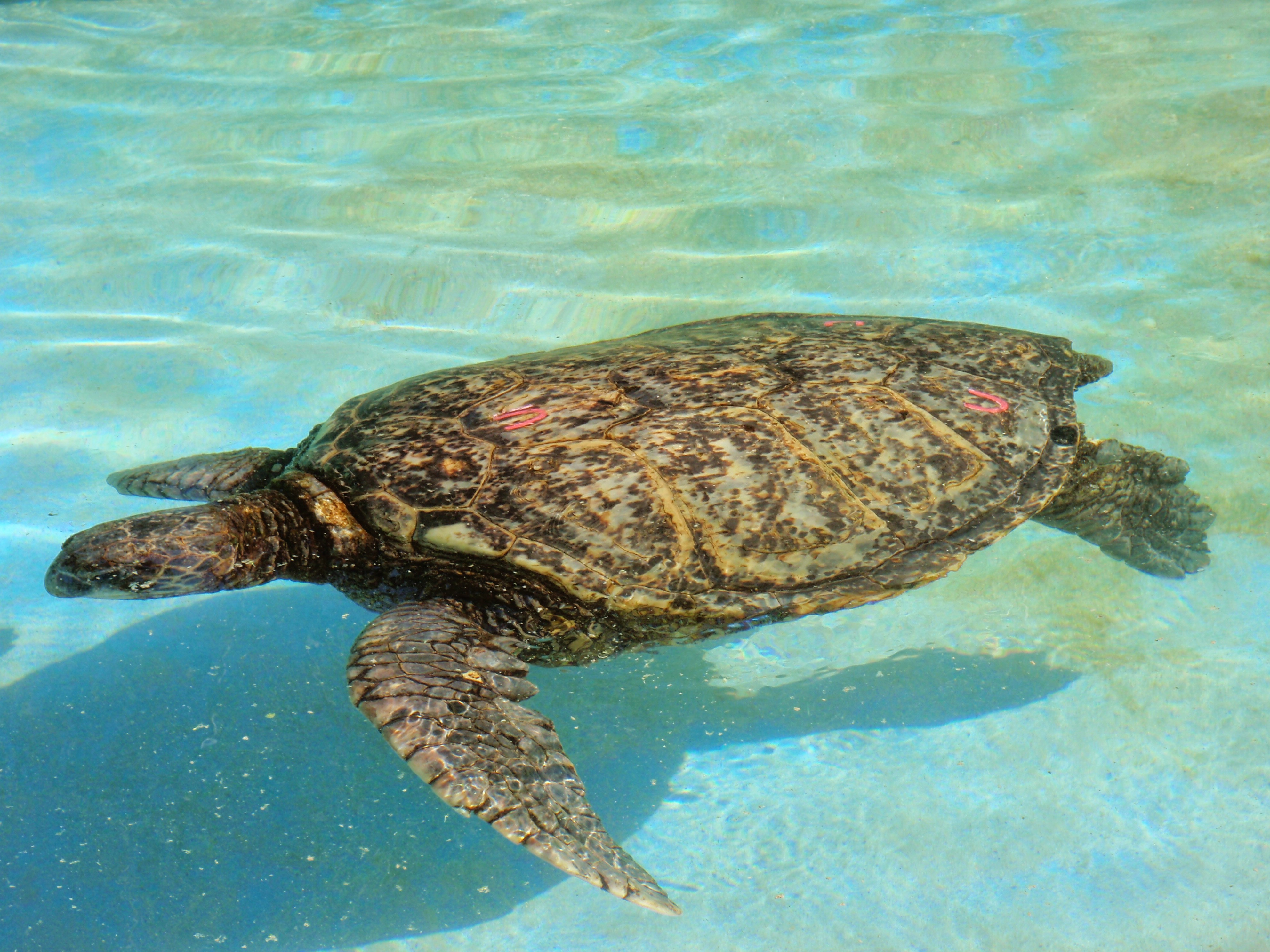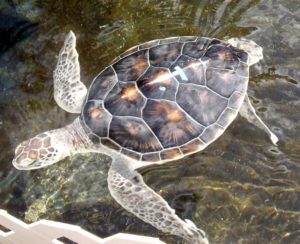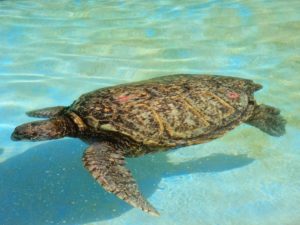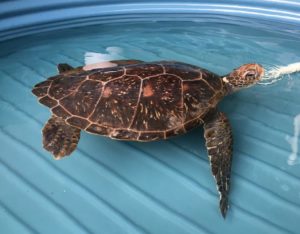To extend upon my series of article regarding cleaning symbiosis and fish cleaners, I will now discuss the cleaning of sea turtles. According to Wikipedia, “Cleaning symbiosis is known from several groups of animals both in the sea and on land. Cleaners include fish, shrimps and birds; clients include a much wider range of fish, marine reptiles including turtles and iguanas, octopus, whales, and terrestrial mammals.”
Neville Coleman’s 1993 book “Australian Fish Behaviour” stated, “ “perhaps the most interesting adaptations to specialised feeding behaviour are to be found amongst those fishes which act as cleaners for other fishes, marine mammals, or reptiles”.
The book went on to describe the very first time that Neville came across some black surgeonfish feeding on the filamentous algae growing on a green turtle’s carapace. That was way back in 1974.
Episode 3 of David Attenborough’s Blue Planet II featured green turtles being cleaned by blennies and black surgeonfish (at 13.30 minutes). I also noticed remoras (suckerfish) attached to the turtles. Remoras are another fish that feed on the external parasites of the host.
Certainly, sea turtles and remoras are rarely seen in South Australian waters, but they do occur here from time to time. Marine turtles in South Australia lists records of sea turtle sightings in South Australia up to 2015. According to that web page, “While marine turtles have no known breeding or nesting sites in South Australia, they are infrequently reported in the sea, or cast up on beaches. The Pacific Ridley is only known to SA from two beach cast specimens found in 2012 and is considered well out of range for the tropical species. Records of the Green turtle are dominated by satellite tracking data from July and August in 2010, where tracking data revealed the species active in Gulf St Vincent and Investigator Strait for an extended period. Records of Leathery turtles are distributed widely across the state and include records inferred from historic newspaper articles.”
I can only wonder just which fish, if any, would clean turtles that enter SA waters.
(Taken in Hawaii by Steve & Noeleen Reynolds)
Rudie Kuiter’s “Guide to Sea Fishes of Australia” suggest that the short suckerfish occurs in SA, whereas the slender suckerfish does not.
I also noticed remoras on some of the sharks featuring in the Blue Planet II series. Remoras are usually only associated with sharks and manta rays, but “Guide to Sea Fishes of Australia” says that they may attach themselves to other fish as well. It also states that “Food is usually obtained when host is feeding or whenever opportunity arises but may take parasitic copepods from host as well”.
According to “Australian Fish Behaviour”, Neville Coleman wasn’t in agreeance as he had never witnessed the removal of parasites by remoras to that stage (1993). Opinions may be divided on the topic, or more information may now lead researchers to accept that remoras feed on the external parasites of the host.
But let’s get back to discussing turtle cleaners. In my earlier article titled Tropical Fish Cleaners and Their Mimics, I wrote, “My Lonely Planet book titled “Diving & Snorkeling Maldives” by Casey Mahaney & Astrid Witte Mahaney includes a page on cleaning stations (page 73). It reads, “turtles often seek out herbivorous tangs eager to rid the turtles of their algae build-up”.”
(Taken in Hawaii by Steve & Noeleen Reynolds)
According to “Hawaii’s Fishes – A Guide for Snorkelers and Divers” by John P Hoover, “Traditional cleaning areas also exist where turtles come to have surgeonfishes and tangs eat the algae off their shells. Sometimes saddle wrasses will pick commensal barnacles of their skin.” A photo on the same page (175) shows several fish picking at the shell of a turtle.
According to Cleaning symbiosis “Cleaning symbiosis is a mutually beneficial association between individuals of two species, where one (the cleaner) removes and eats parasites and other materials from the surface of the other (the client). Cleaning symbiosis is well-known among marine fish, where some small species of cleaner fish, notably wrasses but also species in other genera, are specialised to feed almost exclusively by cleaning larger fish and other marine animals. Other cleaning symbioses exist between birds and mammals, and in other groups.”
Cleaning symbiosis goes on to state, “Cleaning symbiosis is known from several groups of animals both in the sea and on land. Cleaners include fish, shrimps and birds; clients include a much wider range of fish, marine reptiles including turtles and iguanas, octopus, whales, and terrestrial mammals” including: –
(Caribbean and Indo-Pacific coral reefs) Crab Planes minutus
Eat ectoparasites while living on host (Loggerhead sea turtle Caretta caretta)
(Pan-tropical coral reefs: Western Atlantic, Pacific) Decapod Stenopus hispidus (“banded coral shrimp”)
Waves antennae to advertise service; eats parasites, fungi, dead tissue. Fish of various species; hawksbill sea turtle.
(Hawaii submerged lava platform) Cleaner fish, mostly yellow tang (Zebrasoma flavescens) and golden eye surgeon fish (Ctenochaetus)
Fish at cleaning stations forage on shells and skin of turtles; Green sea turtle (Chelonia mydas)
(According to Planes minutus, Planes minutus “is often found in association with turtles, especially the loggerhead sea turtle, Caretta caretta. It had been thought that the crab fed on the turtle’s faeces, but it is now thought to fill a cleaning role”. According to Zebrasoma flavescens, “In the wild, yellow tang provide cleaner services to marine turtles, by removing algal growth from their shells.)
My earlier articles on fish cleaning include: –
Tropical Fish Cleaners and Their Mimics
More About Tropical Fish Cleaners (esp. re Manta Rays as hosts)
The study of fish cleaning behaviour in South Australian waters
Cleaner Clingfish Cleaning Common Seadragons Captured on Camera at Sydney
There is a Facebook page called Southern Australia Sea Turtle Sightings. A green turtle was found at Robe, SA in 2017. Another green turtle was found in the lower south-east of SA in 2016: –
The green turtle found in the lower south-east of SA in 2016




